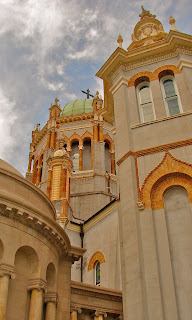
During my last trip to St. Augustine, FL, I really stopped and took the time to enjoy some of the things that the city had to offer. As the oldest continuously occupied European established city, and the oldest port, in the continental United States1, I knew there simply had to be some cemeteries or, at the very least, some churches so rich in history that being there took you back in time.

The Spanish influence of St. Augustine is still alive and thriving today. From its architecture to its spirit, the city is resplendent with an eclectic mix of class, spice and life. Whether you are attending school within a historic landmark such as Flagler College, worshiping at Memorial Presbyterian Church, or simply driving over the Bridge of Lions, one cannot evade the rich sense of history and pride that St. Augustine is inundated with.
Walking along the halls of what is now Flagler College, yet in the late 1800's was a luxury hotel, you can almost feel the brush of fine clothing as if the elite of St. Augustine are rubbing shoulders with you.

In 1885, Henry Flagler began construction on the 540-room Ponce de León Hotel. Learning that the hotel was the first large scale building constructed entirely of poured concrete, it is easy to envision a sterile industrial building. It only goes to show you how versatile concrete is in construction. No, the word "concrete" certainly does not assist in imagining a building that embodies such grandeur as the Ponce de León Hotel truly does.
Today, 124 years later and since purchased by Flagler College, there is still something so majestic about the rust colored steeples and spires that reach towards the Florida sky. With its Spanish Renaissance Revival style with scattered cupolas and its lush surroundings, it is easy to see why this was one of Flagler's few hotels that survived the Great Depression.




There is no contesting that St. Augustine has a heavy spiritual influence just as its greatest influence, Spain, does. While the city has many beautiful and noteworthy churches, Memorial Presbyterian Church is my favorite. With its Venetian Renaissance styled copper dome rising roughly 150 feet overhead and the painstakingly intricate terracotta frieze done by Italian artists, this church is remarkable amongst the Spanish city’s architectural norm and is one of the most attractive sites of St. Augustine.
Original to the first church building, the bell in the east tower and the five pillars surrounding the church are noteworthy as the pillars are made of coquina. Coquina stone is a natural sedimentary rock formed along the east coast of Florida. While Florida may not be well-supplied with what most would consider a "rock", it is well equipped with coquina which is mainly composed of seashells or coral.
The First Presbyterian Church of St. Augustine was organized in 1824, only three years after Florida was bartered to the United States and religious freedom was inculcated in what was before that a Spanish colony. The present-day church building was built, interestingly enough, by Henry Flagler just as the Ponce de León Hotel was. He was the son of a Presbyterian minister. Memorialized for his daughter in 1889 and dedicated in 1890, Flagler had the church erected; and, subsequently the name of the church was changed to Memorial Presbyterian Church.







No comments:
Post a Comment